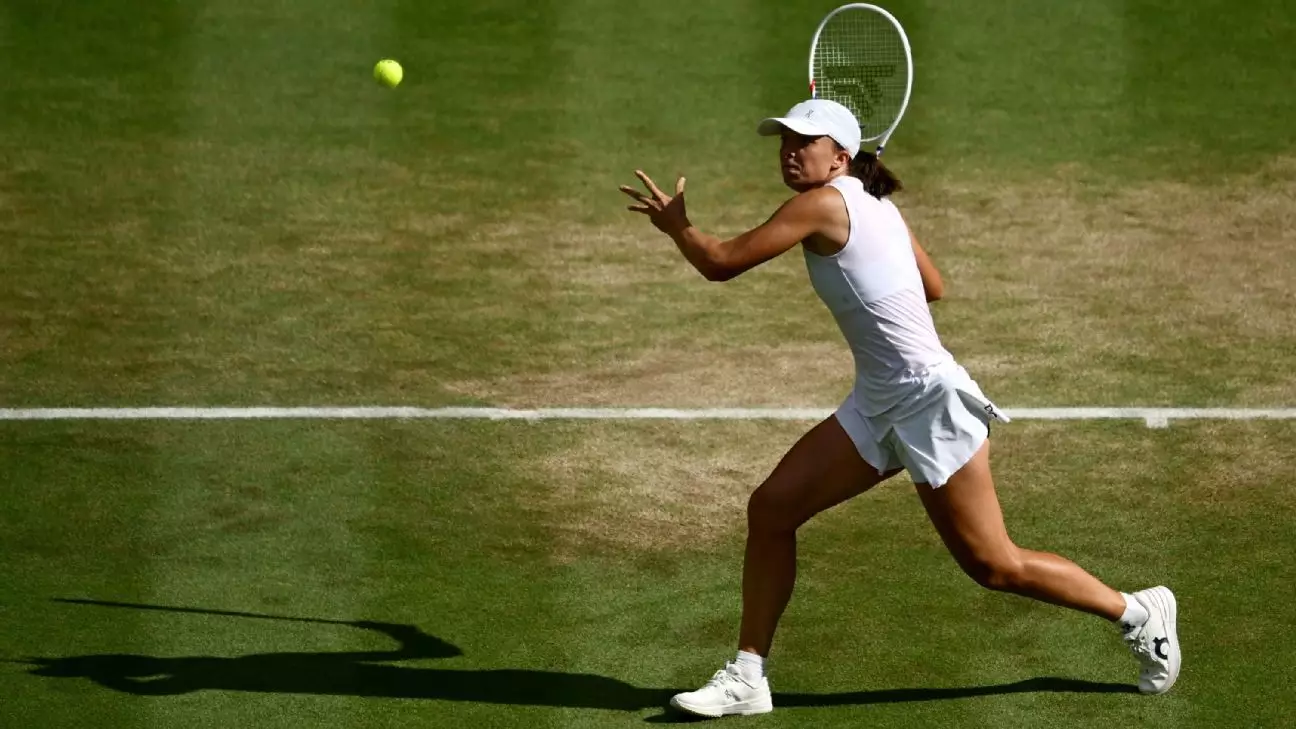Iga Swiatek’s recent Wimbledon performance has been hailed as an extraordinary feat—an almost flawless domination that culminated in a 6-0, 6-0 victory over Amanda Anisimova. While on the surface, it appears to epitomize sheer brilliance, a more critical lens reveals that such narratives often distort the reality of athletic excellence. The symbolism of a double-bagel—rare and historically significant—tends to elevate a moment into an almost mythic spectacle, overshadowing the complex, often uneven landscape of competitive sports. The celebration of Swiatek’s latest achievement tends to gloss over the nuanced disparities that define tennis today, including disparities in access, psychological resilience, and structural inequality within the sport.
Her dominant win, while impressive, invites scrutiny about the level of competition faced. Anisimova, despite her own resilience and talent, lacked the consistency and depth tested across grueling matches to truly challenge Swiatek’s dominance. Moreover, the narrative that Swiatek’s victory on grass—her first WTA title on that surface—signifies a well-rounded athlete neglects the systemic barriers players face in transitioning across different surfaces. Is this victory a reflection of a universally rising skill level, or simply a testament to the gradual evolution of Swiatek’s technical adaptation? A closer examination suggests it’s more the latter, revealing that triumphs like these often serve to reinforce the myth of meritocratic progression, when in reality, many variables shape who reaches the pinnacle.
The Myth of Normalcy and the Reality of Uneven Playing Fields
The portrayal of Swiatek’s journey tends to romanticize her as a prodigy who defied odds, but this narrative masks the deeply ingrained disparities within tennis. With her career being punctuated by a doping ban—albeit due to accidental exposure—her story underscores how fleeting the veneer of fairness can be in high-stakes sports. The privilege of access to top-tier coaching, healthcare, and mental health resources plays an outsized role in shaping success. Swiatek’s rise, while commendable, should not be divorced from the recognition that not all athletes begin their careers on equal footing.
Furthermore, Swiatek’s record—her sixth major title—cements her as one of the most successful active players, but it also raises questions about the sustainability of her dominance in a sport marred by global inequalities. The narrative of a rising star poised to break barriers can often overshadow the fact that many talented players are sidelined by socioeconomic factors, limited resources, or even geopolitical issues. The discourse surrounding her success risks contributing to the illusion that talent alone is enough to attain greatness, ignoring the structural constraints that hinder many others from even competing at this level.
The Cultural Significance: Winners as Symbols, Not Just Athletes
In the broader context, Swiatek’s triumph feeds into a cultural obsession with success as a symbol of virtue and perseverance. While her accomplishments are undeniable, they also reflect a society’s tendency to elevate individual achievement over systemic reform. When narratives focus predominantly on personal grit—like Swiatek’s rise and record-breaking victories—they often obscure the need for systemic change that provides equitable opportunities for diverse athletes worldwide.
Amanda Anisimova’s story highlights this, too. Her comeback from mental health struggles and her perseverance in re-entering the top tier serve as a reminder that the path to success is rarely linear. However, media coverage tends to dismiss the considerable challenges that players face outside of raw athletic talent, simplifying the narrative to one of talent versus dedication. This oversimplification neglects the importance of mental health support, fair pay, and inclusive policies that could democratize access to tennis and empower a broader array of athletes to rise.
The Power Dynamics of Media and Public Perception
Media narratives surrounding Swiatek’s win perpetuate a cycle where success is romanticized while the underlying inequalities of the sport are glossed over. The focus on her record, her resilience, and her historic double-bagel moment generates clicks and applause, but it seldom prompts a deeper analysis of why certain players dominate and others are marginalized. The obsession with “winning at all costs” fosters a culture that values results more than fairness, echoing broader trends within elite sports where history is rewritten in the image of those already on top.
Moreover, the framing of her victory as “perfect” and “instantaneous” risks devaluing the sustained effort and support systems that many players lack. The romanticized heroism can inadvertently reinforce a belief that success is purely a matter of individual effort—an idea that leaves systemic issues unchallenged. For true progress, there must be recognition that athletic achievement is intertwined with social, economic, and political factors that determine who gets to compete and succeed.
It’s critical to question whether these narratives serve the sport’s integrity or simply uphold the status quo—where a select few monopolize glory while countless others remain unseen and unsupported. The glamour of victory, especially when it manifests as a rare double-bagel, should be viewed not just as a triumph of skill but an opportunity to reflect on what the sport needs to become more equitable, inclusive, and genuinely representative of talent from all backgrounds.

